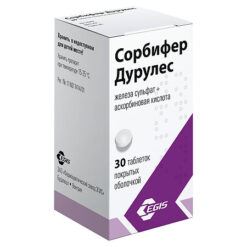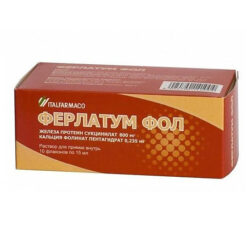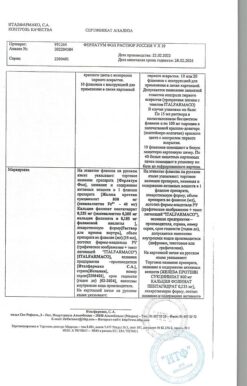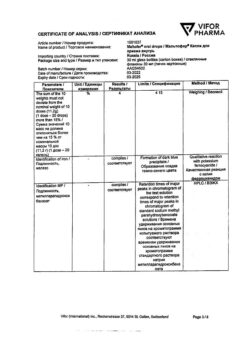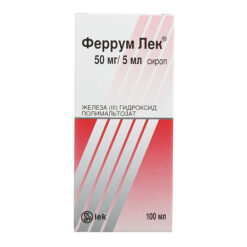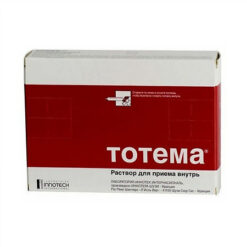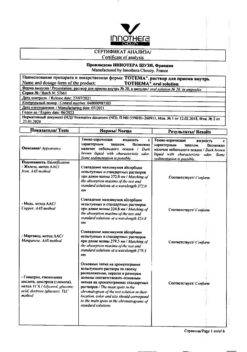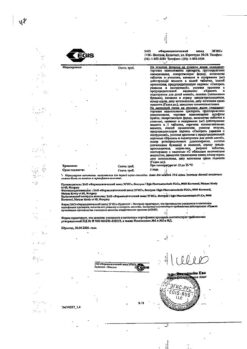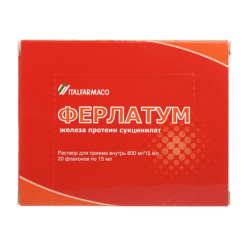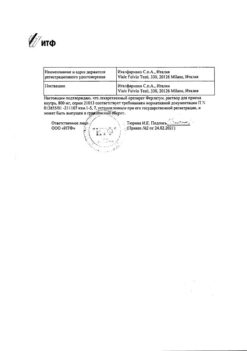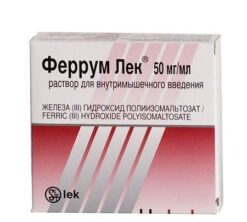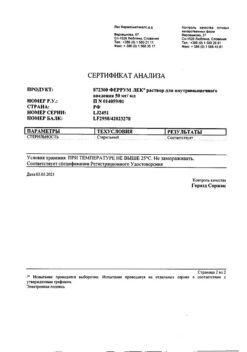No products in the cart.
Aducil, tablets 100 mg 60 pcs
€76.07 €63.39
Description
Antiplatelet agent.
Pharmacokinetics
Absorption
In patients with peripheral arterial occlusive disease, with regular administration of cilostazol at a dose of 100 mg twice daily, the equilibrium concentration of the drug in blood is reached after 4 days.
The maximum concentration (Cmax) of cilostazolum and its major metabolites increases less than proportionally with increasing dose. At the same time, the value of the area under the curve “concentration-time” (AUC) of cilostazol and its main metabolites increases approximately in proportion to increasing the dose.
Distribution and metabolism
Cilostazolol is 95-98% bound to blood proteins, mainly to albumin. Cylostazol is metabolized in the liver mainly by CYP3A4 isoenzyme, to a lesser extent by CYP2C19 isoenzyme, and to an even lesser extent by CYP1A2 isoenzyme. Ciostazol is not an inducer of hepatic microsomal peroxidation enzymes.
Cylostasol is excreted from the body mainly by the kidneys (74%), the remaining drug is excreted through the intestine. In the urine unchanged cilostazolol is practically not determined. Less than 2% of the administered dose is excreted by the kidneys in the form of dehydrocylostazole. Approximately 30% of the administered dose is excreted by the kidneys in the form of 4′-trans-hydroxycylostazole.
The remaining drug is excreted as a variety of metabolites, each of which is no more than 5% of the dose taken.
The elimination half-life of cilostazolol is 10, 5 hours. The two main metabolites, dehydrocylostazole and 4′-trans-hydroxycylostazole, have similar half-lives.
Particular patient groups
In studies involving healthy volunteers aged 50-80 years it was found that age and gender had no significant effect on the pharmacokinetics of cilostazol.
Renal impairment
Patients with severe renal impairment were found to have a 27% higher free fraction of cilostazol, and Cmax and AUC values of unchanged cilostazol were 29% and 39% lower respectively than those with normal renal function.
The Cmax and AUC values of dehydrocylostazole in patients with severe renal impairment are 41% and 47% lower, respectively, than in patients with normal renal function.
The Cmax and AUC of 4′-trans-hydroxycylostazol (the main renal excreted metabolite) are increased by 173% and 209% respectively in patients with severe renal impairment compared to patients without renal impairment. The use of cilostazolum is contraindicated in patients with severe renal impairment (creatinine clearance ≤25 ml/min).
Hepatic impairment
In patients with moderate hepatic impairment, Cmax in plasma and AUC were increased by 25 and 10%, respectively, compared to healthy subjects. In patients with moderate renal impairment, peak plasma concentrations and AUC increased by 50 and 16%, respectively, compared to healthy subjects.
There are no data on the use of cilostazolum in patients with moderate to severe hepatic impairment. Since cilostazolol is largely metabolized by hepatic enzymes of microsomal oxidation, the use is contraindicated in patients with moderate or severe hepatic impairment.
The main mechanism of pharmacological action of cilostazolum is inhibition of phosphodiesterase type 3 (PTE-3) and hence increase of intracellular cyclic adenosine monophosphate (cAMP) content in various organs and tissues.
In experimental and small clinical studies it was found that cilostazol has a vasodilatory effect. Cilostazol inhibits proliferation of human and rat smooth muscle cells under in vitro conditions.
In experimental and clinical studies under in vivo and ex vivo conditions it was found that cilostazol increases the content of cAMP in platelets and causes a reversible anti-aggregant effect. In addition, cilostazol blocks the release of platelet growth factor and platelet factor 4 (PF-4) by human platelets.
Additional potentially beneficial effects of cilostazol found in experimental and clinical studies were decreased serum triglyceride concentrations and increased high-density lipoprotein (HDL) cholesterol concentrations.
In a clinical study, taking cilostazol at a dose of 100 mg twice daily for 12 weeks compared to placebo reduced blood triglycerides by an average of 0.33 mmol/L (15%) and increased HDL cholesterol by an average of 0.10 mmol/L (10%).
Cilostazol has a positive inotropic effect. In experimental studies, cilostazol had a species-specific damaging effect on the cardiovascular system.
The efficacy of cilostazolum in patients with intermittent claudication has been confirmed in 9 placebo-controlled clinical trials.
The therapy with cilostazolum at a dose of 100 mg twice daily for 24 weeks was found to approximately double maximal walking distance (from 60.4 m to 129.1 m; the average absolute increase in maximal walking distance is 42 m) and the distance walked before pain appeared (from 47.3 m to 93.6 m).
The efficacy of the drug in patients with diabetes mellitus was lower than in those without carbohydrate metabolism disorder. In a prospective double-blind clinical trial, cilostazol did not increase mortality in patients with intermittent claudication.
Indications
Indications
Cilostazol is used to increase maximum and pain-free walking distance in patients with intermittent claudication who have no rest pain and no signs of peripheral tissue necrosis (Fontaine grade II lower limb ischemia).
Cilostazol is intended for use as second-line therapy in patients with intermittent claudication in whom lifestyle changes (including smoking cessation and [supervised] physical rehabilitation programs) and other appropriate interventions have been insufficient to reduce the symptoms of intermittent claudication.
Pharmacological effect
Pharmacological effect
Antiplatelet agent.
Pharmacokinetics
Absorption
In patients with occlusive diseases of peripheral arteries, when regularly taking cilostazol at a dose of 100 mg 2 times a day, the equilibrium concentration of the drug in the blood is achieved after 4 days.
The maximum concentration (Cmax) of cilostazol and its main metabolites increases less than proportionally with increasing dose. In this case, the area under the concentration-time curve (AUC) of cilostazol and its main metabolites increases approximately in proportion to the dose.
Distribution and metabolism
Cilostazol is 95-98% bound to blood proteins, mainly albumin. Cilostazol is metabolized in the liver mainly by the CYP3A4 isoenzyme, to a lesser extent by the CYP2C19 isoenzyme, and to an even lesser extent by the CYP1A2 isoenzyme. Cyostazol is not an inducer of hepatic microsomal peroxidation enzymes.
Plasma concentrations of dehydrocilostazol and 4′-trans-hydroxycilostazol (estimated based on AUC) are approximately 41% and approximately 12% of the concentration of unchanged cilostazol, respectively. Dehydrocilostazol and 4′-trans-hydroxycilostazol are bound to blood proteins by 97.4% and 66%, respectively.
Removal
Cilostazol is excreted from the body primarily by the kidneys (74%), the remaining drug is excreted through the intestines. Unchanged cilostazol is practically undetectable in urine. Less than 2% of the dose taken is excreted by the kidneys in the form of dehydrocylostazol. Approximately 30% of the dose taken is excreted by the kidneys in the form of 4′-trans-hydroxycilostazol.
The remaining drug is excreted in the form of various metabolites, each of which constitutes no more than 5% of the dose taken.
The half-life of cilostazol is 10.5 hours. The two main metabolites, dehydrocilostazol and 4′-trans-hydroxycilostazol, have similar half-lives.
Special patient groups
In studies involving healthy volunteers aged 50-80 years, it was found that age and gender do not have a significant effect on the pharmacokinetics of cilostazol.
Kidney failure
It was found that in patients with severe renal failure, the free fraction of cilostazol is 27% higher, and the Cmax and AUC of unchanged cilostazol are 29% and 39% lower, respectively, than in individuals with normal renal function.
The Cmax and AUC values of dehydrocilostazol in patients with severe renal failure are 41% and 47% lower, respectively, than in patients with normal renal function.
At the same time, the Cmax and AUC values of 4′-trans-hydroxycilostazol (the main metabolite excreted by the kidneys) in patients with severe renal failure increase by 173% and 209%, respectively, compared with patients without impaired renal function. The use of cilostazol is contraindicated in patients with severe renal impairment (creatinine clearance ≤25 ml/min).
Liver failure
In patients with moderate hepatic impairment, plasma Cmax and AUC increased by 25 and 10%, respectively, compared with healthy controls. In patients with moderate renal impairment, peak plasma concentrations and AUC were increased by 50 and 16%, respectively, compared with healthy controls.
There are no data on the use of cilostazol in patients with moderate to severe hepatic impairment. Since cilostazol is extensively metabolized by hepatic microsomal oxidation enzymes, use is contraindicated in patients with moderate or severe hepatic impairment.
Pharmacodynamics
The main mechanism of pharmacological action of cilostazol is the inhibition of phosphodiesterase type 3 (PTE-3) and, consequently, an increase in the intracellular content of cyclic adenosine monophosphate (cAMP) in various organs and tissues.
Experimental and small clinical studies have shown that cilostazol has a vasodilating effect. Cilostazol inhibits the proliferation of human and rat smooth muscle cells in vitro.
In experimental and clinical studies in in vivo and ex vivo conditions, it was found that cilostazol increases the cAMP content in platelets and causes a reversible antiplatelet effect. In addition, cilostazol blocks the release of platelet-derived growth factor and platelet-derived factor 4 (PF-4) from human platelets.
Additional potentially beneficial effects of cilostazol found in experimental and clinical studies were a decrease in serum triglyceride concentrations and an increase in high-density lipoprotein (HDL) cholesterol concentrations.
In a clinical study, taking cilostazol 100 mg twice daily for 12 weeks compared with placebo reduced blood triglycerides by an average of 0.33 mmol/L (15%) and increased blood HDL cholesterol by an average of 0.10 mmol/L (10%).
Cilostazol has a positive inotropic effect. In experimental studies, cilostazol had species-specific damaging effects on the cardiovascular system.
The effectiveness of cilostazol in patients with intermittent claudication was confirmed in 9 placebo-controlled clinical trials.
Treatment with cilostazol 100 mg twice daily for 24 weeks was found to approximately double the maximum walking distance (from 60.4 m to 129.1 m; mean absolute increase in maximum walking distance was 42 m) and the distance walked before the onset of pain (from 47.3 m to 93.6 m).
The effectiveness of the drug in patients with diabetes mellitus was lower than in persons without impaired carbohydrate metabolism. In a prospective, double-blind clinical trial, cilostazol was found not to increase mortality in patients with intermittent claudication.
Special instructions
Special instructions
Before initiating cilostazol therapy, the possibility of prescribing other treatment options, such as surgical revascularization or conservative therapy, should be assessed.
Due to the mechanism of pharmacological action, cilostazol can cause tachycardia, palpitations, tachyarrhythmia and/or arterial hypotension. When taking cilostazol, your heart rate may increase by 5-7 beats per minute.
In patients at risk (for example, patients with stable angina), an increase in heart rate may trigger an attack of angina. It is necessary to carefully monitor the condition of such patients.
Caution should be exercised when prescribing cilostazol to patients with atrial or ventricular premature beats, as well as patients with atrial fibrillation or atrial flutter.
Patients should be warned to report any bleeding or bruising (subcutaneous hematoma) from a minor injury. If hemorrhage develops in the retina, cilostazol should be discontinued.
Because cilostazol is a platelet aggregation inhibitor, there is an increased risk of bleeding during surgery (including minor invasive procedures such as tooth extraction). For planned surgical interventions (if the antiplatelet effect is undesirable), cilostazol should be discontinued 5 days before surgery.
Rare or very rare cases of hematological disorders have been reported, including thrombocytopenia, leukopenia, agranulocytosis, pancytopenia or aplastic anemia. In most cases, these disorders resolved after discontinuation of cilostazol. However, pancytopenia and aplastic anemia have been fatal in several cases.
The patient should be warned to immediately report to the physician any symptoms that may be early manifestations of hematologic complications, such as high fever (pyrexia) and sore throat. A complete blood count should be performed if an infection is suspected or clinical symptoms of hematological complications appear.
Cilostazol should be discontinued immediately if clinical symptoms or laboratory signs of hematologic complications occur.
Caution should be exercised when simultaneous use of cilostazol with drugs that lower blood pressure (possibility of additive hypotensive effect with the development of reflex tachycardia) and also reduce blood clotting or inhibit platelet aggregation.
Impact on the ability to operate vehicles using machinery
Cilostazol may cause dizziness. It is recommended to be careful when driving vehicles or operating machinery during the treatment period.
Active ingredient
Active ingredient
Cilostazol
Composition
Composition
Tablets – 1 tablet:
Active ingredient: 100 mg of cilostazol;
Excipients: corn starch, microcrystalline cellulose 101, calcium carmellose, hypromellose, magnesium stearate.
Pregnancy
Pregnancy
Pregnancy
There are no data on the use of cilostazol in pregnant women.
Experimental studies on animals have shown that cilostazol has reproductive toxicity.
The use of cilostazol during pregnancy is contraindicated.
Breastfeeding period
Experimental studies on animals have shown that cilostazol passes into breast milk. It is unknown whether cilostazol passes into breast milk in humans. Due to possible adverse effects on the newborn, the use of cilostazol during breastfeeding is contraindicated.
Fertility
Experimental studies found that cilostazol did not have an adverse effect on the fertility of laboratory animals.
Contraindications
Contraindications
Hypersensitivity to cilostazol or any other component of the drug;
Severe renal failure (creatinine clearance ≤25 ml/min);
Moderate or severe liver failure;
Chronic heart failure;
Predisposition to bleeding (for example, gastric or duodenal ulcer in the acute stage, recent (within the last 6 months) hemorrhagic stroke, proliferative diabetic retinopathy, poorly controlled arterial hypertension);
Ventricular tachycardia, ventricular fibrillation or polytopic ventricular extrasystole in history (regardless of the presence or absence of adequate antiarrhythmic therapy);
Prolonged QT interval on ECG;
History of severe tachyarrhythmia;
Unstable angina or myocardial infarction within the last 6 months;
Invasive intervention on the coronary arteries within the last 6 months;
Concomitant use of two or more antiplatelet or anticoagulant drugs (for example, acetylsalicylic acid, clopidogrel, heparin, warfarin, acenocoumarol, dabigatran, rivaroxaban or apixaban);
Concomitant use of potent inhibitors of CYP3A4 or CYP2C19 (for example, cimetidine, diltiazem, erythromycin, ketoconazole, lansoprazole, omeprazole and HIV-1 protease inhibitors);
Pregnancy;
Breastfeeding period;
Age under 18 years (safety and effectiveness have not been studied).
With caution:
Mild liver failure;
Chronic ischemic heart disease (in particular, stable angina pectoris);
Atrial or ventricular extrasystole, atrial fibrillation and flutter;
Diabetes mellitus;
Concomitant use of medications that lower blood pressure;
Simultaneous use of drugs that reduce blood clotting;
Concomitant use of CYP3A4 or CYP2C19 substrates (for example, cisapride, midazolam, nifedipine, verapamil);
Old age.
Side Effects
Side Effects
In clinical studies, the most common adverse reactions were headache (30%), diarrhea (15%), and bowel dysfunction (15%). These adverse reactions were usually of mild or moderate intensity, and sometimes their severity decreased with decreasing dosage of the drug.
Other side effects reported in clinical trials and post-marketing use of cilostazol are listed below.
Adverse reactions according to the frequency of occurrence were classified as follows: Very common: ≥1/10, Frequent: from ≥1/100 to
Adverse reactions observed during post-marketing use of cilostazol preparations are classified as side effects with unknown frequency (frequency cannot be determined based on available data).
From the blood and lymphatic system
Frequent
Ecchymosis
Infrequent
Anemia
Rare
Increased bleeding time, thrombocytosis
Frequency unknown
Bleeding tendency, thrombocytopenia, granulocytopenia, agranulocytosis, leukopenia, pancytopenia, aplastic anemia
Immune system disorders
Infrequent
Allergic reactions
Metabolic and nutritional disorders
Frequent
Edema (peripheral edema, facial edema), anorexia
Infrequent
Hyperglycemia, diabetes mellitus
Mental disorders
Infrequent
Anxiety
Nervous system disorders
Very frequent
Headache
Frequent
Dizziness
Infrequent
Insomnia, sleep disturbance (unusual dreams)
Frequency unknown
Paresis, hyperesthesia
Visual disorders
Frequency unknown
Conjunctivitis
Hearing and labyrinth disorders
Frequency unknown
Tinnitus
Heart disorders
Frequent
Palpitations, tachycardia, angina pectoris, arrhythmia, ventricular extrasystole
Infrequent
Myocardial infarction, atrial fibrillation, chronic heart failure, supraventricular tachycardia, ventricular tachycardia, syncope
Frequency unknown
Polymorphic ventricular tachycardia of the “pirouette” type and prolongation of the QTc interval (in patients with diseases of the cardiovascular system).
Vascular disorders
Frequent
Ocular hemorrhage, epistaxis, gastrointestinal bleeding, orthostatic hypotension
Infrequent
Hot flashes, arterial hypertension, arterial hypotension, intracranial hemorrhage, pulmonary hemorrhage, intramuscular hematomas, bleeding from the respiratory tract, subcutaneous hemorrhage
Respiratory, thoracic and mediastinal disorders
Frequent
Rhinitis, pharyngitis
Infrequent
Shortness of breath (dyspnea), pneumonia, cough
Frequency unknown
Interstitial pneumonia
Gastrointestinal disorders
Very frequent
Diarrhea, stool disorders
Frequent
Nausea, vomiting, dyspepsia, flatulence, abdominal pain
Infrequent
Gastritis
Disorders of the liver and biliary tract
Frequency unknown
Hepatitis, deviation of liver function tests from normal values, jaundice
Skin and subcutaneous tissue disorders
Frequent
Skin rash, itchy skin
Infrequent
Eczema, skin rashes, Stevens-Johnson syndrome, toxic epidermal necrolysis, urticaria
Musculoskeletal and connective tissue disorders
Infrequent
Myalgia
Renal and urinary tract disorders
Rare
Kidney failure, renal dysfunction
Frequency unknown
Hematuria, pollakiuria
General and administration site disorders
Frequent
Chest pain, asthenia
Infrequent
Chills, malaise
Frequency unknown
Hyperthermia, pain
Laboratory and instrumental data
Frequency unknown
Increased uric acid in the blood, increased urea in the blood, increased creatinine in the blood
Cilostazol has an increased risk of bleeding and this risk may be increased when used concomitantly with other medicinal products with similar effects.
The risk of intraocular bleeding may be higher in patients with diabetes.
An increase in the frequency of diarrhea and palpitations was noted in patients over 70 years of age.
Interaction
Interaction
Platelet aggregation inhibitors
Cilostazol is a PDE-3 inhibitor with antithrombotic activity. Its use in healthy individuals at a dose of 150 mg for 5 days did not lead to prolongation of bleeding time.
Acetylsalicylic acid
Short-term (for ≥4 days) simultaneous use of cilostazol and acetylsalicylic acid leads to a 23-25% increase in blocking ADP-induced platelet aggregation in ex vivo conditions compared to acetylsalicylic acid monotherapy.
There was no apparent trend toward an increase in hemorrhagic adverse events in patients receiving cilostazol and aspirin compared with patients receiving placebo and an equivalent dose of acetylsalicylic acid.
Clopidogrel and other antiplatelet drugs
In a study in healthy volunteers, coadministration of cilostazol with clopidogrel had no effect on platelet count, prothrombin time (PT), and activated partial thromboplastin time (APTT).
When clopidogrel was used either as monotherapy or in combination with cilostazol, bleeding time increased in healthy volunteers. Taking cilostazol did not lead to an additional significant prolongation of bleeding time.
However, caution is recommended when cilostazol is used concomitantly with any drug that inhibits platelet aggregation. It is recommended to regularly monitor bleeding time.
The use of cilostazol is contraindicated in patients receiving two or more antiplatelet and/or anticoagulant drugs simultaneously.
Oral anticoagulants
In a clinical study, a single dose of cilostazol did not inhibit the metabolism of warfarin and had no effect on blood clotting parameters (PT, APTT, bleeding time). However, caution is recommended when cilostazol is used concomitantly with any anticoagulant drug.
The use of cilostazol is contraindicated in patients receiving two or more antiplatelet and/or anticoagulant drugs simultaneously.
Inhibitors of cytochrome P-450 isoenzymes
In the liver, cilostazol is mainly metabolized by cytochrome P-450 enzymes, predominantly CYP3A4 and CYP2C19 and, to a lesser extent, CYP1A2. It is believed that dehydrocilostazol, which is 4-7 times superior to cilostazol in its ability to inhibit platelet aggregation, is formed mainly with the participation of CYP3A4. 4′-trans-hydroxycilostazol, which has five times less pronounced ability to inhibit platelet aggregation, is formed mainly under the influence of CYP2C19.
Accordingly, drugs that inhibit CYP3A4 (eg, some macrolides [erythromycin, clarithromycin], azole antifungals [ketoconazole, itraconazole], protease inhibitors) and CYP2C19 (eg, proton pump inhibitors [omeprazole, esomeprazole]) increase the overall pharmacological activity of cilostazol and may increase its adverse effects.
Accordingly, patients receiving strong inhibitors of CYP3A4 or CYP2C19 are recommended to be prescribed cilostazol at a dose of 50 mg twice daily.
When cilostazol was co-administered with erythromycin (a strong CYP3A4 inhibitor), the AUC values of cilostazol, dehydrocilostazol and 4-trans-hydroxycilostazol increased by 72%, 6% and 119%, respectively. Based on changes in AUC values, it was found that the overall pharmacological activity of cilostazol when used simultaneously with erythromycin increases by 34%.
Based on these data, it is recommended to use cilostazol 50 mg twice daily concomitantly with erythromycin or similar drugs (eg, clarithromycin).
When cilostazol is co-administered with ketoconazole (a strong CYP3A4 inhibitor), the AUC of cilostazol increases by 117%, the AUC of dehydrocilostazol decreases by 15%, and the AUC of 4′-trans-hydroxycilostazol increases by 87%.
Based on changes in AUC values, it was found that the overall pharmacological activity of cilostazol when used simultaneously with ketoconazole increases by 35%. Based on these data, it is recommended to use cilostazol 50 mg twice daily when coadministered with kenoconazole or similar drugs (eg, itraconazole).
When cilostazol was co-administered with diltiazem (a weak CYP3A4 inhibitor), the AUC values of cilostazol, dehydrocilostazol and 4′-trans-hydroxycilostazol increased by 44%, 4% and 43%, respectively.
Based on changes in AUC values, it was found that the overall pharmacological activity of cilostazol when used simultaneously with diltiazem increases by 19%. No dose adjustment of cilostazol is required when used concomitantly with diltiazem.
With a single dose of 100 mg of cilostazol simultaneously with 240 ml of grapefruit juice (intestinal CYP3A4 inhibitor), no significant changes in the pharmacokinetic parameters of cilostazol were observed. No dose adjustment of cilostazol is required.
However, taking larger amounts of grapefruit juice may affect the pharmacokinetics of cilostazol.
When cilostazol was co-administered with omeprazole (a strong CYP2C19 inhibitor), the AUC of cilostazol and dehydrocilostazol increased by 22% and 68%, respectively, while the AUC of 4′-trans-hydroxycilostazol decreased by 36%.
Based on changes in AUC values, it was found that the overall pharmacological activity of cilostazol when used simultaneously with omeprazole increases by 47%. It is recommended to reduce the dose of cilostazol to 50 mg 2 times a day when used simultaneously with omeprazole.
Substrates of cytochrome P-450 isoenzymes
Cilostazol increases the AUC of lovastatin (a CYP3A4 substrate) and its beta-hydroxyl metabolite by 70%. Caution is advised when coadministering cilostazol with CYP3A4 substrates that have a narrow therapeutic index (such as cisapride, halofantrine, pimozide, ergot alkaloids).
It is also recommended to exercise caution when using cilostozol concomitantly with HMG-CoA reductase inhibitors (statins) that metabolize via CYP3A4 (simvastatin, atorvastatin and lovastatin).
Inducers of cytochrome P-450 isoenzymes
The effect of drugs that increase the activity of CYP3A4 and CYP2C19 (such as carbamazepine, phenytoin, rifampicin, St. John’s wort preparations) on the pharmacokinetics of cilastazol has not been studied. With simultaneous use, it is theoretically possible to reduce the antiplatelet effect of cilostazol, so bleeding time should be regularly monitored.
In clinical studies, it was found that smoking (a factor that enhances the activity of CYP1A2) reduces the concentration of cilostazol in the blood plasma by 18%.
Other medicines
Caution should be exercised when co-using cilostazol with antihypertensive drugs, as well as any other drugs that potentially lower blood pressure (including nitrates and phosphodiesterase-5 inhibitors), since an additive hypotensive effect with the development of reflex tachycardia is possible.
An increase in heart rate and peripheral edema has been noted with simultaneous use of cilostazol and other vasodilating agents, such as dihydropyridine calcium channel blockers.
Overdose
Overdose
Information on acute overdose in humans is limited. Expected symptoms are severe headache, diarrhea, tachycardia and possibly heart rhythm disturbances.
It is necessary to empty the stomach by inducing vomiting, or perform gastric lavage in accordance with generally accepted recommendations.
Patient monitoring and supportive treatment are necessary.
Manufacturer
Manufacturer
Adamed Pharma, Poland
Additional information
| Manufacturer | Adamed Pharma, Poland |
|---|---|
| Medication form | pills |
| Brand | Adamed Pharma |
Related products
Buy Aducil, tablets 100 mg 60 pcs with delivery to USA, UK, Europe and over 120 other countries.


